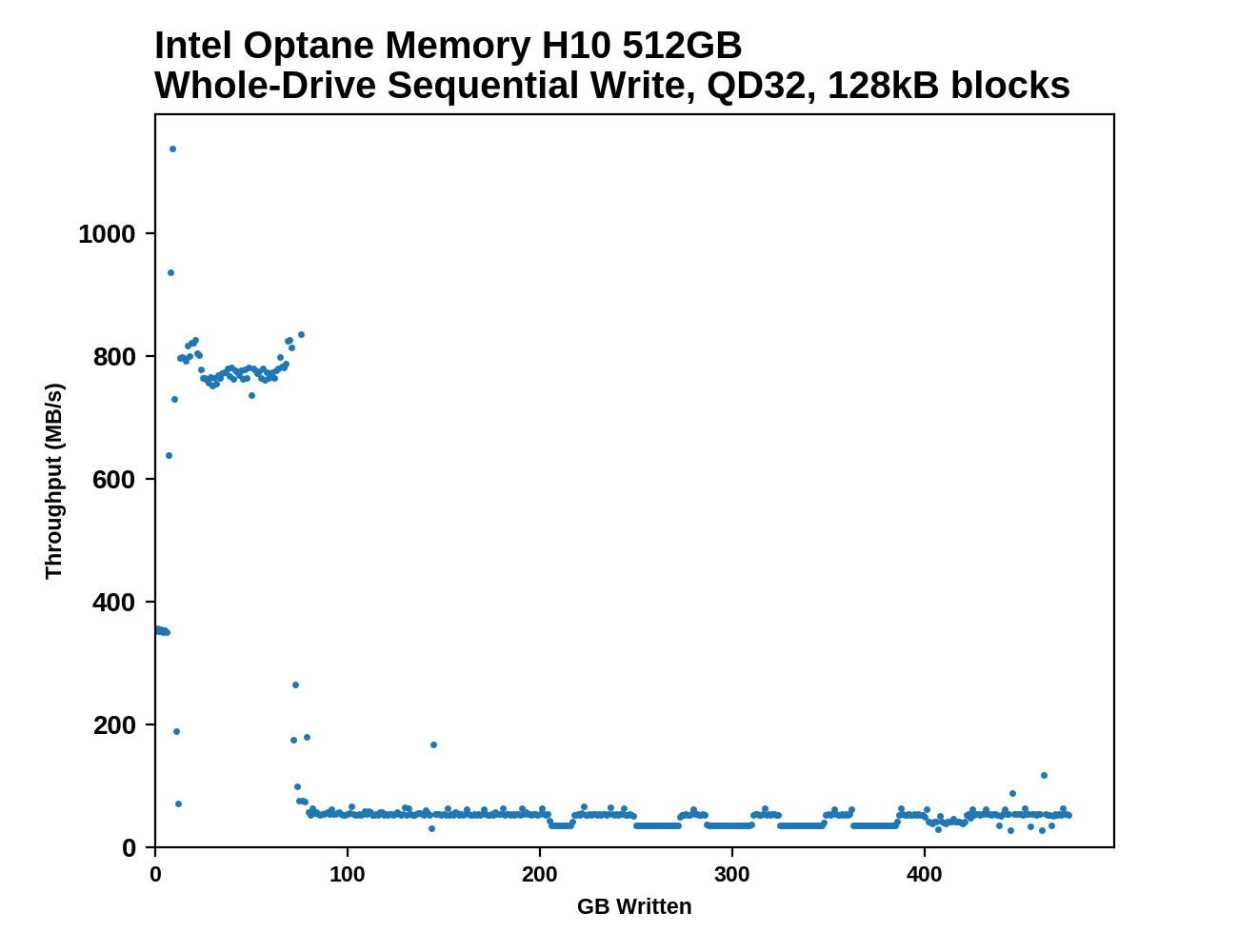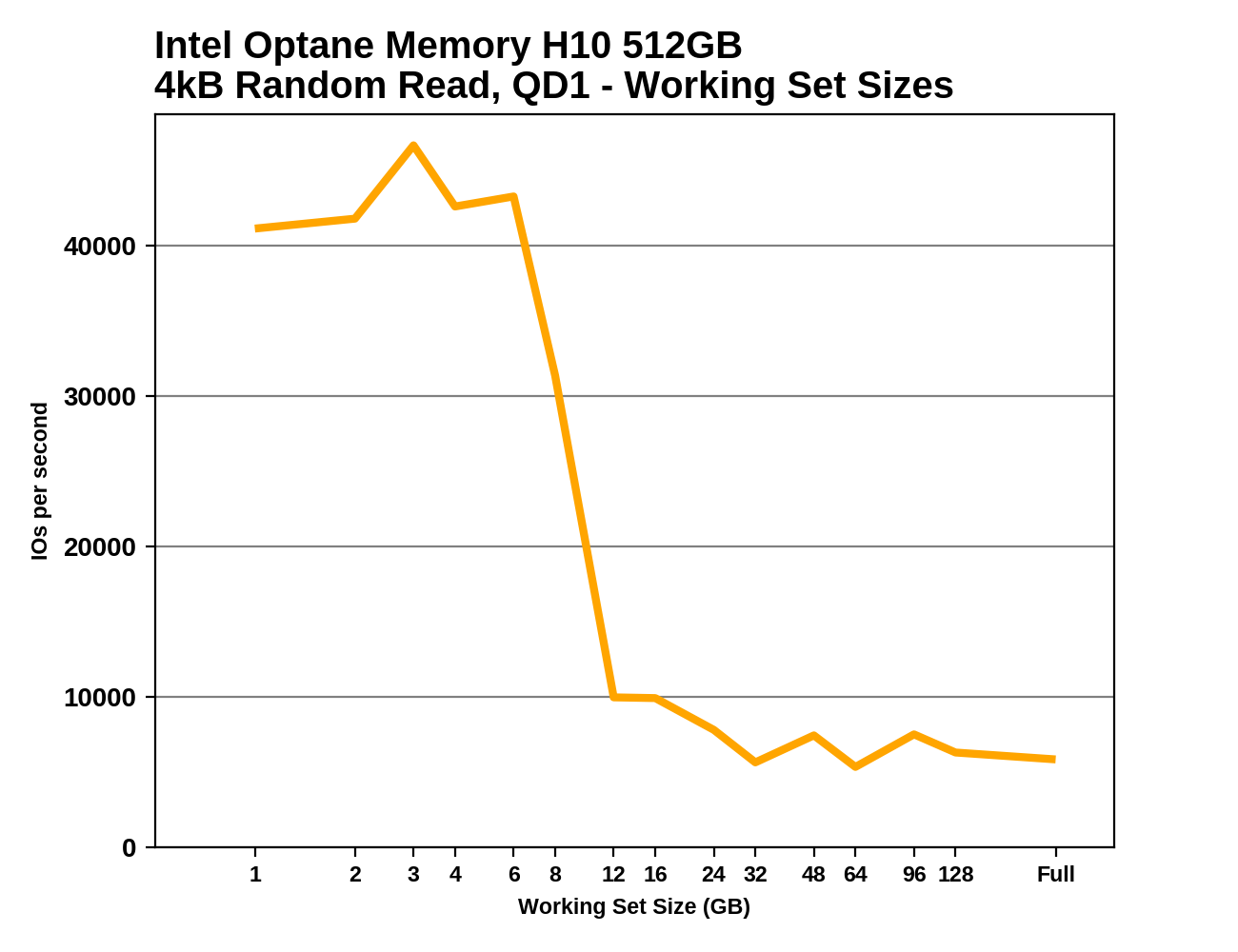The Intel Optane Memory H10 Review: QLC and Optane In One SSD
by Billy Tallis on April 22, 2019 11:50 AM ESTWhole-Drive Fill
This test starts with a freshly-erased drive and fills it with 128kB sequential writes at queue depth 32, recording the write speed for each 1GB segment. This test is not representative of any ordinary client/consumer usage pattern, but it does allow us to observe transitions in the drive's behavior as it fills up. This can allow us to estimate the size of any SLC write cache, and get a sense for how much performance remains on the rare occasions where real-world usage keeps writing data after filling the cache.
 |
|||||||||
During a sustained write, the Optane cache on the Intel Optane Memory H10 doesn't change the situation much from how the QLC-only Intel 660p behaves—the Optane cache on its own is only good for about 350MB/s. The SLC write cache on the NAND side is a more important factor that helps sustain high write speed far beyond the 32GB size of the Optane cache. But eventually, all the caches fill up and the very slow write speed of raw QLC takes over.
 |
|||||||||
| Average Throughput for last 16 GB | Overall Average Throughput | ||||||||
The overall average write speed when completely filling the Optane Memory H10 is unsurprisingly lower than any of the other drives in this batch. The 1TB Intel 660p was already a bit slower than a 7200RPM hard drive, and our H10 sample has half as much QLC to work with.
Working Set Size
 |
|||||||||
The Optane cache on the H10 is 32GB, but when testing random reads it appears to only be good for about 6-8GB working sets before the cache starts thrashing and performance drops down to roughly what a QLC-only drive can offer. It appears that Intel may be reserving a large portion of the Optane cache to serve as a write buffer, and this might be detrimental to the most read-intensive workloads.










60 Comments
View All Comments
SaberKOG91 - Monday, April 22, 2019 - link
Nothing special about my usage on my laptop. Running linux so I'm sure journals and other logs are a decent portion of the background activity. I also consume a fair bit of streaming media so caching to disk is also very likely. This machine gets actively used an average of 10-12 hours a day and is usually only completely off for about 8-10 hours. I also install about 150MB of software updates a week, which is pretty on par with say windows update. I also use Spotify which definitely racks up some writes.I can't speak to the endurance of that drive, but it is also MLC instead of TLC.
I would argue that it means that the cost per GB of QLC is now low enough that the manufacturing benefit of smaller dies for the same capacity is worth it. Most consumer SSDs are 250-500GB regardless of technology.
I'm not referring to a few faulty units or infant mortality. I can't remember the exact news piece, but there were reports of unusually high failure rates in the first generation of Optane cache modules. I also wasn't amused when Anandtech's review sample of the first consumer cache drive died before they finished testing it. You're also assuming that they only factor in the failure of a drive is write endurance. It could very well be that overheating, leakage buildup, or some other electrical factor lead to premature failure, regardless of TBW. It's also worth noting that you may accelerate drive death if you exceed the rated DWPD.
RSAUser - Tuesday, April 23, 2019 - link
I'm at about 3TB after nearly 2 years, this with adding new software like android etc. And swapping between technologies constantly and wiping my drive once every year.I also have Spotify, game on it, etc.
There is something wrong with your usage if you have that much write? I have 32GB RAM so very little caching though, so could be the difference.
IntelUser2000 - Tuesday, April 23, 2019 - link
"You're also assuming that they only factor in the failure of a drive is write endurance. It could very well be that overheating, leakage buildup, or some other electrical factor lead to premature failure, regardless of TBW."I certainly did not. It was in reply to your original post.
Yes, write endurance is a small part of a drive failing. If its failing due to other reasons way before warranty, then they should move to remedy this.
Irata - Tuesday, April 23, 2019 - link
You are forgetting the sleep state on laptops. That alone will result in a lot of data being written to the SSD.jeremyshaw - Sunday, July 14, 2019 - link
Or they have a laptop with the "Modern Standby," which is code for:Subpar idle state which goes to Hibernation (flush RAM to SSD - I have 32GB of RAM) whenever the system drains too much power in this "Standby S3 replacement."
voicequal - Monday, April 22, 2019 - link
"Optane has such horrible lifespan at these densities that reviewers destroyed the drives just benchmarking them."What is your source for this comment?
SaberKOG91 - Monday, April 22, 2019 - link
Anandtech killed their review sample when Optane first came out. Happened other places too.voicequal - Tuesday, April 23, 2019 - link
Link? Anandtech doesn't do endurance testing, so I don't think it's possible to conclude that failures were the result of worn out media.FunBunny2 - Wednesday, April 24, 2019 - link
"Since our Optane Memory sample died after only about a day of testing, we cannot conduct a complete analysis of the product or make any final recommendations. "here: https://www.anandtech.com/show/11210/the-intel-opt...
Mikewind Dale - Monday, April 22, 2019 - link
I don't understand the purpose of this product. For light duties, the Optane will be barely faster than the SLC cache, and the limitation to PCIe x2 might make the Optane slower than a x4 SLC cache. And for heavy duties, the PCIe x2 is definitely a bottleneck.So for light duties, a 660p is just as good, and for heavy duties, you need a Samsung 970 or something similar.
Add in the fact that this combo Optane+QLC has serious hardware compatibility problems, and I just don't see the purpose. Even in the few systems where the Optane+QLC worked, it would still be much easier to just install a 660p and be done with it. Adding an extra software layer is just one more potential point of failure, and there's barely any offsetting benefit.